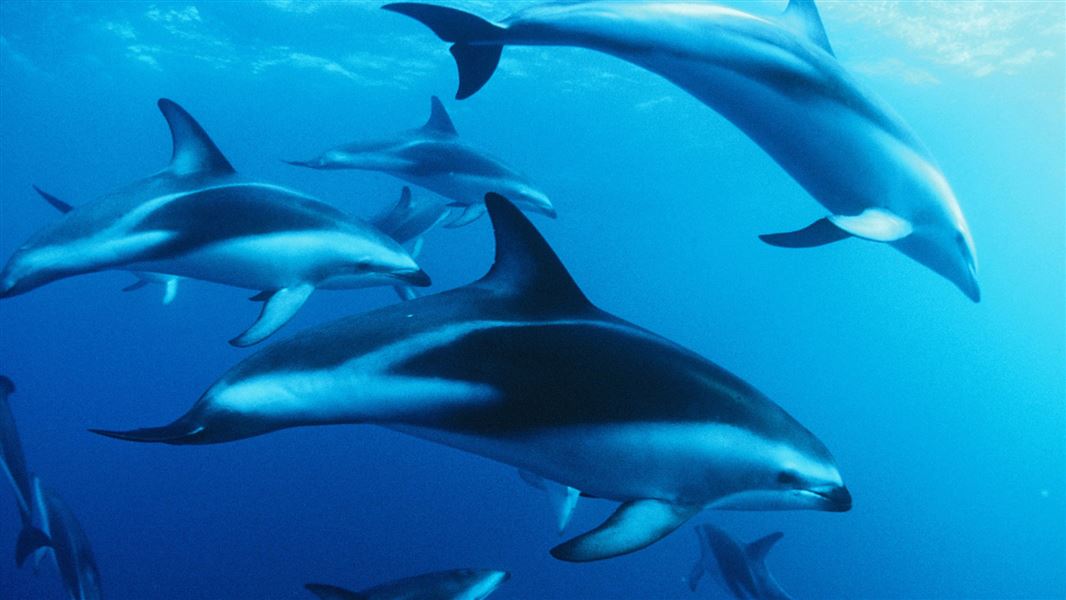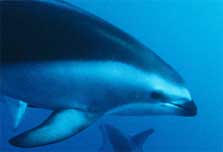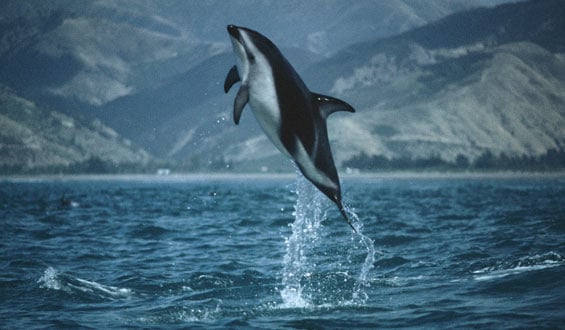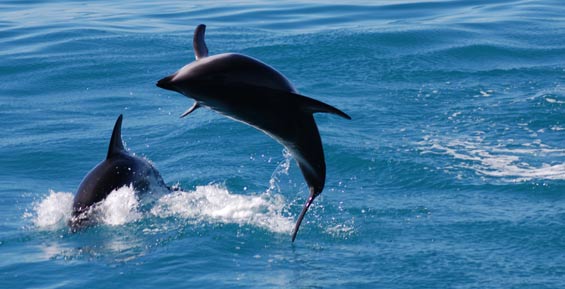
Introduction
In New Zealand, dusky dolphins appear south of East Cape and are rare in more northern waters.Dusky dolphins have virtually no beak, and their dorsal fin is not hooked and rather blunt.
They are a bluish-black colour on the back and tail and white on the underside of the body.
A female dusky dolphin grows to a maximum length of 1.93 m, while the males are slightly larger with a maximum length of 2.11 m. A newborn is usually around 0.92 m.
Dusky dolphins (Lagenorhynchus obscurus) are confined to the southern hemisphere in temperate and subantarctic waters between around 26°S and 55°N.
Main populations occur around South America, off south western Africa and in New Zealand waters. In New Zealand, dusky dolphins appear south of East Cape and are rare in more Northern waters.
They have been recorded as far south as Campbell Island and east out to the Chatham Islands, with main populations occurring in Kaikoura and Admiralty Bay in the Marlborough Sounds.
Large groups of several hundred to over 1000 dusky dolphins are present in Kaikoura all year round with individuals moving north to feed at Admiralty in winter months.
Duskys are a highly coastal species and generally prefer waters less than 2000 m deep.
Population
Due to their coastal nature, populations of dusky dolphins around the world are discontinuous and reproductively isolated. Large-scale migrations are known to occur in New Zealand however, and inshore-offshore movements are made both diurnally and seasonally with dolphins moving further offshore in winter.
Overall, group sizes range from two to over one-thousand. There are thought to be between 12,000 and 20,000 individuals in New Zealand (Markowitz, 2004).
Dusky dolphins interact with a variety of other marine mammals including common dolphins, long-finned pilot whales, bottlenose dolphins, Hector’s dolphins, killer whales, New Zealand fur seals, sperm whales, Southern right whales and humpback whales.

Dusky dolphin

Dusky dolphin leaping out of the water
Diet and foraging
The diet of this species is dominated by anchovies, hake and several squid species. A variety of other small fish species is also eaten. In Kaikoura, dusky dolphins typically feed at night on prey associated with the deep scattering layer.
Individuals are known to adapt foraging methods to habitat and prey availability patterns, with the same dolphins, identified by natural markings, being found feeding cooperatively during the day in the Marlborough Sounds. Admiralty Bay is used regularly by 200-300 dolphins as a winter foraging habitat.
Surface feeding activities occur in large groups accompanied by extensive aerial display and acrobatics, which are believed to help synchronize cooperative foraging. Cooperative foraging can also be seen between dusky dolphins and other marine mammals such as New Zealand fur seals.
Breeding
Sexual maturity is reached at approximately 7-8 years. Calving in New Zealand occurs from November to mid-January. Gestation lasts for around 13 months and weaning occurs in less than 3 years. Dusky dolphins are estimated to live to ages of 30 years or more.
Video of a newborn dusky dolphin
Threats
Predators
Killer whales and some shark species are the only confirmed predators of dusky dolphins. In order to avoid killer whales, dusky dolphins will move into shallower water and swim closer together.
Human impact
Unknown numbers of dusky dolphins are caught in set nets in New Zealand waters each year. Current catches appear to have decreased from those of the 1970s and 1980s however.
Possible future expansion of aquaculture at Admiralty Bay is likely to have an impact on dusky dolphin populations through habitat fragmentation and competition for food resources.
Our work with dusky dolphin
We are currently focusing its management for this species on mitigating the impacts of tourism at Kaikoura. We are also responsible for managing stranding events.
Report sightings
You can report sightings of dolphins to our conservation hotline 0800 DOCHOT (0800 362 468). You can also report a sighting online.
Reports of sightings are always valuable and help increase our knowledge of dolphin distribution and movements around New Zealand.
If you need help identifying species, download the marine mammal sighting form (PDF, 416K) (Word, 4,300K). You can use the images and descriptions to find out which species of dolphin you observed.
Record the details
Include as much information as possible with your sighting:
- the date, time and location (GPS coordinates if possible)
- the number of dolphins and estimated sizes
- the direction they were travelling
- take photographs or video if possible.
You can help
How to approach dolphins
From a commercial or recreational boat:
- Carefully approach dolphins from their side and slightly to the rear.
- Operate your boat slowly and quietly at ‘no wake’ speed within 300 m.
- Don't approach a group of dolphins if three or more boats are already within 300 m of the group.
- Manoeuvre your boat carefully. Do not obstruct their path, cut through a group, or separate mothers from calves.
From a recreational boat or swimming:
- Avoid loud or sudden noises that could startle dolphins.
- Don't swim with dolphins when calves are present.
- Don't try to touch the dolphins or feed them.
- Cooperate with others so all may see the dolphins without putting them at risk.
Stranded, injured, entangled, or deceased dolphins
Call DOC's emergency hotline immediately 0800 DOC HOT (0800 362 468) and follow any instructions from DOC staff. Prompt reporting increases the likelihood that we can save dolphins in distress and learn more about deceased dolphins. This may include conducting necropsies in some situations to identify the cause of death, and collecting important scientific data that may help us manage threats to dolphins.
How you can help in a stranding.
If you catch or harm a dolphin
It is not illegal to accidentally catch a dolphin, but you must report it.
If you accidentally catch, harm or kill a dolphin you must report it as soon as possible to our emergency hotline 0800 DOCHOT (0800 362 468) or the Ministry for Primary Industries (0800 008 333).
If a dolphin is alive you should release it back into the water as quickly and gently as possible, provided it is safe to do so.
If the dolphin is dead, take photos, and either release the carcass at sea or preferably bring it to shore for us to recover, particularly if you have caught a Hector's or Māui dolphin.
Find out more about sharing our coasts with marine mammals.
Set nets
If you are set netting always remain with your net. Remove your net from the water if dolphins are seen in the area.
If you see set nets being used within areas closed for netting, contact the Ministry for Primary Industries on 0800 4 POACHER (0800 4 76224).
